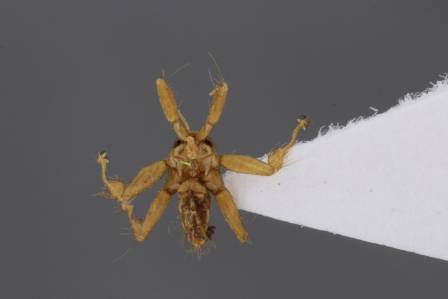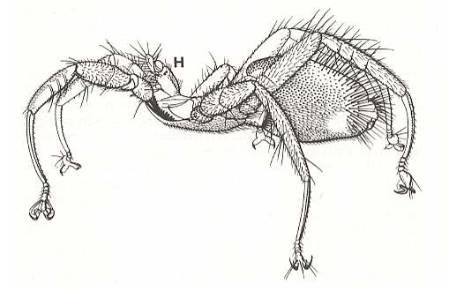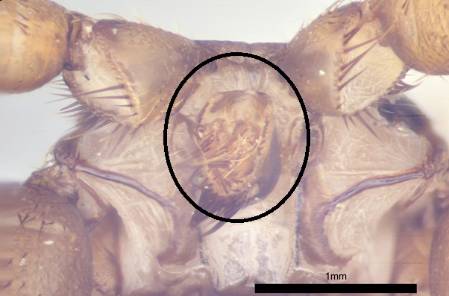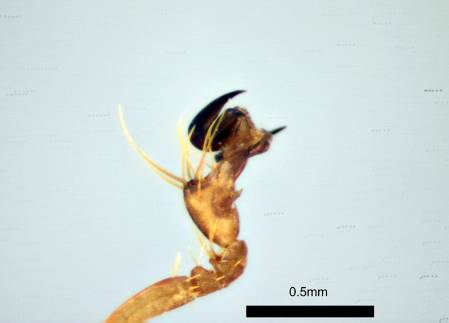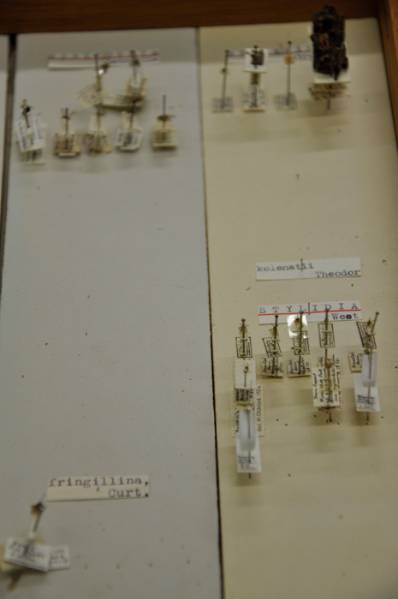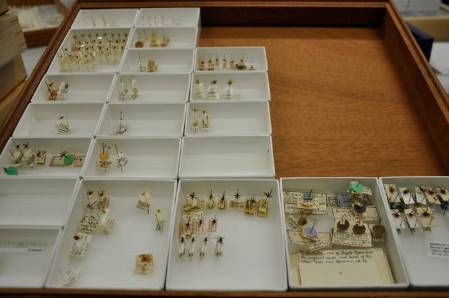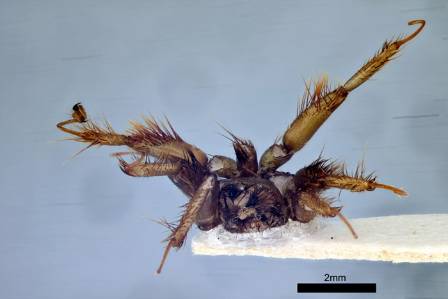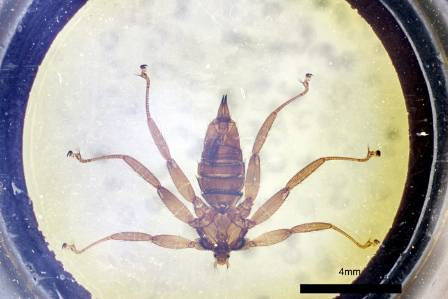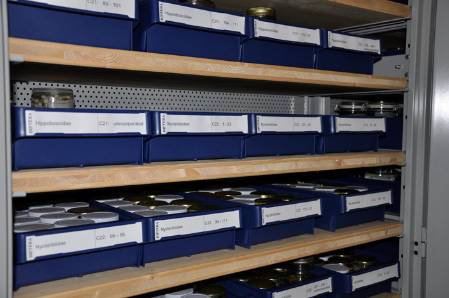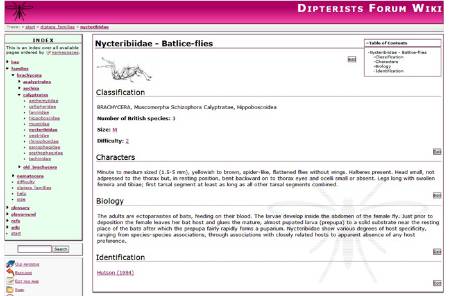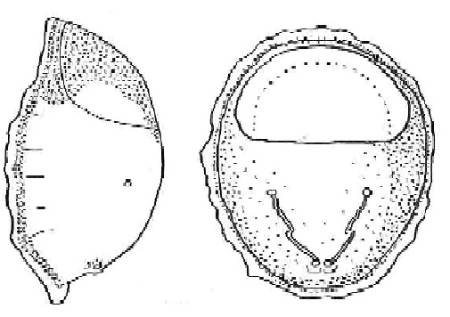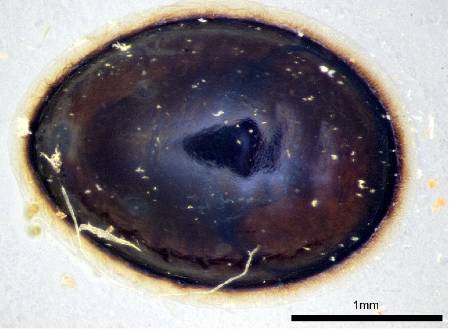So I am interrupting the Peruvian blog instalments for an exciting little group of flies. One of my colleagues - Hillery Warner - left this on my desk the other day. She works many floors above me on the mantid collection and whilst recurating that collection this little critter was discovered.
At first she thought it may have just been some ‘crud’ (my technical term), but very quickly realised what it was (after all, we are the Natural History Museum and can spot and describe insects from 100 yards – we're more likely to walk into walls etc than the average person but nevertheless very good at the little things) .
Can you see it? Upon closer inspection I became very excited.
Ok here is a close up:
Still nothing? a mutated spider maybe?
The very strange-looking batlice fly.
The family of flies that I am writing about are the Nycteribiidae – the batlice flies. These are some of the oddest looking flies that you will come across. For a start they are wingless – and no they are not therefore referred to as walks… But we do know that they are flies as they have retained their halteres (balancing organs). Their weird body shape is because all of their wing muscles have atrophied – they have completely dissolved away resulting in an incredibly small thorax.
The batlice fly has an extremely small thorax.
So the head and legs are basically dorsal insertions of the thorax – they stick out of the top of the fly rather than at the side which is the more usual way. It is really difficult to work out which way is up as the head does not resemble anything that you are used to.
The head is the hairy ovoid structure inserted after the 2 front legs and is conspicuously small with either no eyes or very small ones.
And just look at their legs – amazingly well adapted for holding onto the fur of bats. Their tarsal segments are completely bendy with huge claws.
Their legs are amazingly well adapted for holding onto the fur of bats.
Here is a lovely description of them from Metafysica:
The upper surface of the thorax is little more than a framework of hard chitin, joined together with large areas of soft membrane, and the head is a grotesque structure apparently sitting on top of the thorax. Indeed, any one seeing a Nycteribiid for the first time is likely to mistake the under surface for the upper, and fail to find the head at all! The eyes are greatly reduced, and may be absent altogether. When they are present they are quite unlike those of other adult flies, being either a single, round facet, or two little lenses on a black mount.
These things are only on average 5mm but adaptation to their environment is what it is all about. So batlice flies, as the name suggests, live on bats – they are ectoparasites (living externally on the host) and feed exclusively on their blood (both the male and female flies). Every five days they take in their own body weight in blood. Little and often is definitely their motto.
What is odd about the specimen that appeared on my desk is that it came off a mantid – one could only presume that it was using the mantid for transport (phoresis) but that leads to the next question of where was the mantid? Was it hanging around caves etc? Very puzzling.
Globally there are 274 described species. Most of them are found in the old world tropics although there are species in the Neotropics and Europe. Upon researching this group most of the species that have recently been described are from South America although this is probably a reflection on how many dipterists live in South America rather than it suddenly being species rich.
SUBFAMILY | GENERA | DISTRIBUTION | HOST |
Archinycteribiinae | Archinycteribia | Malaysia - Bismark | Megachiroptera |
Cyclopodia> | Paleotropical | Megachiroptera | |
| Dipseliopoda | ||
| Eucampsipoda | ||
| Leptocyclopodia | ||
Nycteribiinae | Basilia | Worldwide | Microchiroptera |
| Hershkovitzia | ||
| Nycteribia | ||
| Penicillidia | ||
| Phthiridium | ||
| Stereomyia |
Now within Europe we only have 13 of these crazy little things, but that drops to just 3 in the British Isles.
There we go - the British pinned collection of batlice flies.
The world pinned collection does not look that much better…
So I think that you may be able to work out from this that most of the collection is not pinned. Some have been nicely pinned (as pictured) but most of the time they are just mangled legs on a pin.
Most of our collection of batlice flies is either preserved as slide material or spirit material.
The slide material is of much higher quality than the pinned and you can see some very clear features – check out the shoulder pads on this one.
This is the bulk of our collection – the spirit material. In the collection we have 235 species listed in the catalogue – which is excellent!
Now below is the page on batlice flies from the Dipterists Forum:
Which leads me onto the very exciting larval stage – ahhh maggots – once more back into familiar territory. Now batlice flies, along with the rest of the Hippoboscoidea (the superfamily which includes this family and about 4 others – I say about as there is some dispute..), do not lay eggs. In fact, they are much more like mini-mammals (ok so I am stretching that one a bit). In fact they have a specific larval development referred to as Adenotrophic (gland-fed) viviparity (live birth).
All of the larval stages (of which this family has three) occur within a genital chamber. When they say there is very little parental care we can name hundreds of species within Diptera that do so. I know that I may come across as biased at times but flies really are the only species that you ever need to study. The head of the larva is enclosed in the anterior part of the uterus and receives nourishment from these milk glands.
The females leave the bat host when they are about to give birth (as it were). She crawls onto the wall of the cave and the pre-pupal stage emerges. This is an incredibly short stage as the larva pupate within hours. Now there are some great larval body adaptations to help this wee one stick to the cave wall. They are hemi ovoid – and have sticky secretions which are also helped by a narrow marginal skirt (see diagram below).
The movement of the pre-pual stage ensures that it has an airtight seal. But – BUT - just to make sure the female backs over it and presses down on it with her body! Incredible. If anyone has a film that I could see of that I would be forever in your debt! What a fantastically odd family.





